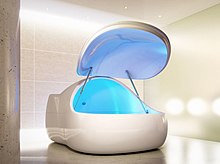Isolation tank
An isolation tank, often referred to as a sensory deprivation tank (also known as float tank, float pod, float cabin, flotation tank, or sensory attenuation tank) is a pitch-black, light-proof, soundproof environment heated to the same temperature as the skin. Flotation tanks are widely advertised as a form of alternative medicine, but beneficial health effects are unproven. The tank is filled with 10 inches of water which contains enough dissolved Epsom salt to create a specific gravity of approximately 1.275. This environment allows an individual to float effortlessly on the surface of the water. The primary function of the isolation tank is to eliminate as many of the external senses as possible. They were first used in 1954 to test the effects of sensory deprivation.

History
The isolation tank was developed in 1954 by John C. Lilly, a medical practitioner and neuropsychiatrist.[1][2][3] During his training in psychoanalysis at the US National Institute of Mental Health (NIMH), Lilly experimented with sensory deprivation.
Widespread commercial interest and use of the isolation tank didn't occur until 1972, when Glenn Perry, a computer systems programmer, began selling the first commercial tanks after he attended a five-day workshop by Lilly.[4]
In 1981, there were about $4 million in sales and rentals in the industry, and expectations were that the market would grow, spurred by the film Altered States (a film starring William Hurt as a psychopathologist experimenting with a flotation tank), which came out in 1980.[5] According to one source in the industry, in the 1980s the rise of AIDS and the fear of shared water reduced demand for flotation centers.[6] By 2013, flotation was more popular in Europe than the US, but had undergone some growth in the area around San Francisco; at that time a low-end tank cost about $10,000, and an hour-long flotation session cost about $70.[6]
Notable users
- Carl Lewis, track and field athlete, used in-tank visualization techniques to prepare himself for his gold medal long jump at the 1988 Seoul Olympics.[7]
- Richard Feynman, Nobel Prize-winning physicist, discussed his experiences with isolation tanks in Surely You're Joking, Mr. Feynman![8]
- Two-time NBA MVP Stephen Curry reportedly uses a sensory-deprivation tank every two weeks.[9]
- Carl Lawson, football player for the Cincinnati Bengals, uses the tank for muscle recovery and visual training.[10]
- Joe Rogan has stated in his podcast on numerous occasions that he owns an isolation tank and credits it for allowing a state of deeper meditation.[11]
- John Lennon treated his heroin addiction in 1979 with the help of 90-minute floats in a cedar-wood box.[4]
- Several NFL teams, including the New England Patriots, Los Angeles Rams and New Orleans Saints, reportedly use floating as a way to increase players’ quality of sleep as well as help with recovery. [12]
- During Super Bowl XLIX, both NFL teams (the New England Patriots and Seattle Seahawks) rented out a local float spa during the week of the event. One team would float in the morning and the other would float in the afternoon.[13]
- Marvin Jones, wide receiver for the Detroit Lions and formerly of the Cincinnati Bengals, began using flotation therapy to help him in his recovery from an ankle injury while in Cincinnati, and continues to float after discovering how beneficial it was in other areas as well. [14]
- Markiplier and Ethan Nestor (CrankGameplays) constructed and tested a makeshift isolation chamber in a video on their joint channel Unus Annus, November 19, 2019.[15]
- Phil Lester visited a floatation center for a YouTube video on his channel "AmazingPhil" on February 17, 2020.[16]
References
- Black, David (December 10, 1979). "Lie down in darkness". New York Magazine. 12 (48): 60. ISSN 0028-7369.
- Gelb, Michael; Sarah Miller Caldicott (2007). Innovate Like Edison. Dutton. pp. 140. ISBN 978-0-525-95031-8.
- Lilly, John Cunningham (1996). The Scientist: A Metaphysical Autobiography (3 ed.). Ronin Publishing. pp. 102. ISBN 0-914171-72-0.
- deBara, Deanna (2018-01-17). "What Is Floating? Inside the Fitness Trend That Steph Curry and Joe Rogan Swear By". Men's Health. Retrieved 2019-07-06.
- "Relaxation Tanks: A Market Develops". The New York Times. 21 November 1981.
- Efrati, Amir. "Float Centers Gaining Steam". The Wall Street Journal. Retrieved May 15, 2013.
- "Flotation Tanks, Three Powerful Healing Therapies in One!". CNN iReport. Archived from the original on 2016-09-24. Retrieved 2016-09-23.
- Cole, K.C. (January 27, 1985). "Book Review: Surely you're joking Mr Feynman". The New York Times.
- Alipour, Sam (8 December 2015). "Stephen Curry on copying the Warriors' way: 'You won't have the personnel'". ESPN. Retrieved 13 December 2016.
- "How do some NFL players relax before games? They float". ESPN.com. 2017-10-28. Retrieved 2019-07-06.
- https://www.menshealth.com/fitness/a19546617/sensory-deprivation-tanks/
- https://www.si.com/nfl/2019/02/01/patriots-sleep-float-tanks-bill-belichick-josh-mcdaniels-tom-brady/
- https://floattherapy.com/why-athletes-benefit-from-float-therapy/
- https://zenfloatco.com/floating-for-athletic-performance/
- Making Our Own Sensory Deprivation Tank, November 18, 2019
- https://www.youtube.com/watch?v=iPLPkbf9DaQ/
| Wikimedia Commons has media related to Isolation tank. |